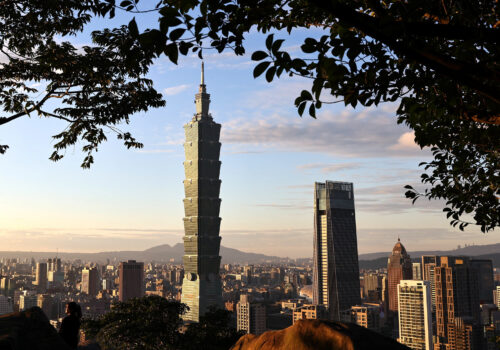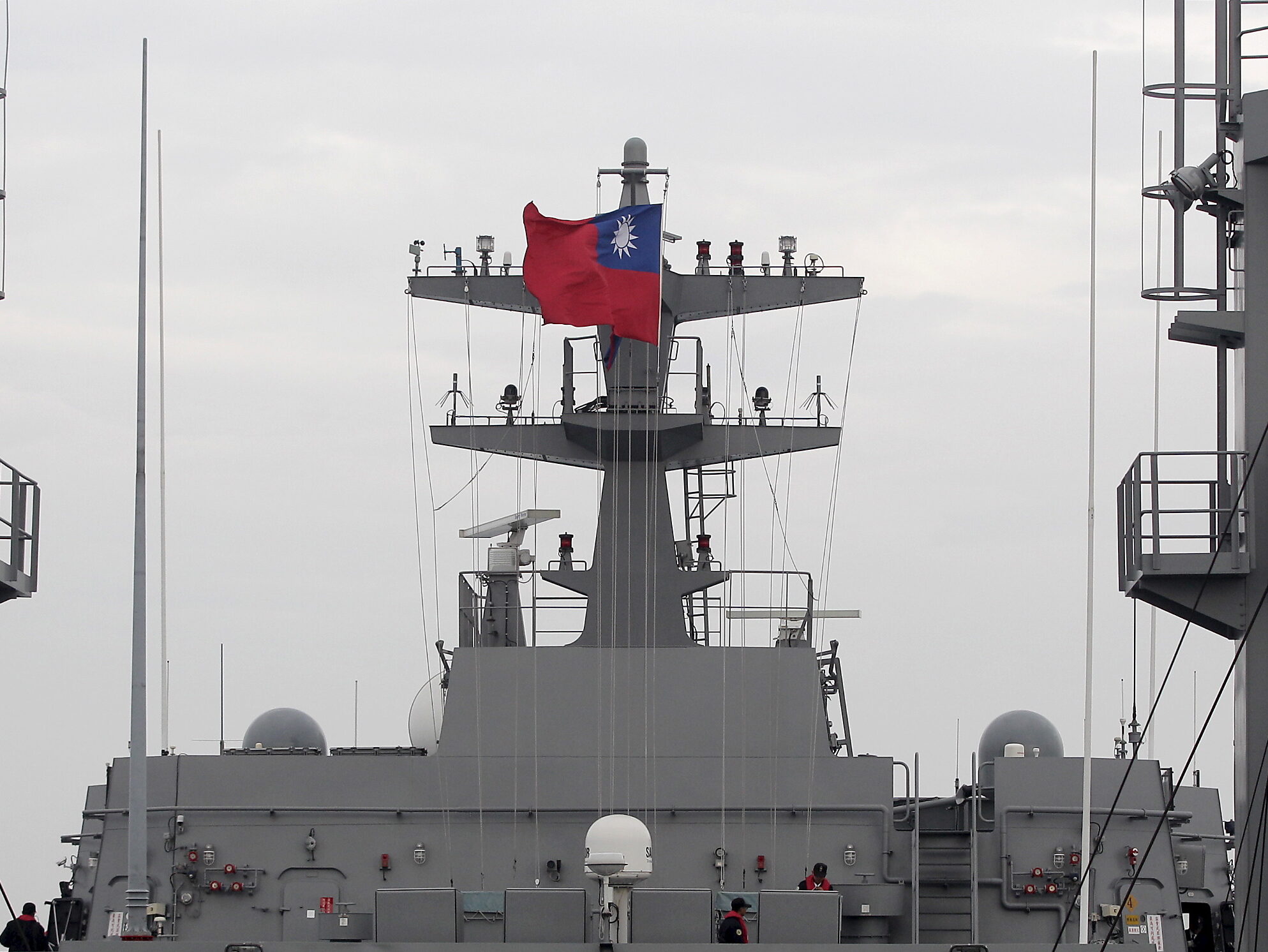April 24, 2025
Defending Taiwan means mobilizing society, not just the military
Click on the banner above to explore the Tiger Project.
Taiwan is under unprecedented pressure from the People’s Republic of China (PRC), facing coordinated threats on multiple fronts. The PRC employs a comprehensive strategy to strangle Taiwan’s dwindling diplomatic space, pollute its public discourse with disinformation and misinformation, and apply pressure using both military and civilian means. It also wields its vast economic power to punish the island nation—as well as countries, companies, and individuals that support Taiwan.
Under the former Tsai Ing-Wen administration and the current Lai Ching-Te administration, Taiwan has taken significant steps toward ensuring that it remains a free and vibrant democracy. Last June, Lai announced the establishment of the Whole-of-Society Defense Resilience Committee at the Presidential Office to ensure that both the government and society would be able to maintain normal operations in the event of a crisis in the Taiwan Strait. The committee gathers senior leaders and representatives across a wide swath of Taiwan’s government, civil society, business, nongovernmental organizations, and academia to formulate strategy and provide recommendations in five key areas: civilian force training and utilization; strategic material preparation and critical supply distribution; energy and critical infrastructure operations and maintenance; social welfare, medical care, evacuation facility readiness, information, and transportation; and financial network protection.
In July 2024, the Scowcroft Center for Strategy and Security published “Toward resilience: An action plan for Taiwan in the face of PRC aggression.” The Center for Strategic and International Studies (CSIS) followed with its “Strengthening Resilience in Taiwan” report in December 2024. These two reports provide an accurate assessment of the challenges of creating societal resilience and share policy recommendations for the Taiwan Whole-of-Society Defense Resilience Committee. However, additional perspectives—especially across social, technological, and economic dimensions—can help expand Taiwan’s approach to societal resilience.
Preparing for crisis—without spreading fear
Organizing the necessary stakeholders around a shared framework with a clearly defined and understood vision was the easy part. However, as with all large bureaucracies, Taiwan’s resilience committee faces significant challenges in getting both the government and other actors to accept and implement difficult trade-offs. These trade-offs require people, departments, and various parts of Taiwanese society to give up money, power, or influence in order to achieve the necessary reforms and make them sustainable for the long term.
A key pitfall for Taiwan was failing to persuade its people, in plain language, why it needed to create the Whole-of-Society Defense Resilience Committee in the first place. Taiwan’s resilience ultimately hinges on the public understanding that the PRC can, and might, use its full suite of tools and capabilities against the island, should Xi Jinping conclude that a takeover is otherwise unattainable. The government needs to explain how everyday citizens can prepare in the event of that type of crisis. As demonstrated by Taiwan’s response to multiple natural disasters, its government is a global leader in terms of orienting local and national efforts to recover and quickly return to a pre-disaster state. However, the resilience committee has the challenging task of learning how to balance preparing Taiwan for manmade emergencies, such as a maritime blockade or military invasion, without unnecessarily creating a sense of panic.
This May, a television miniseries titled Zero Day is set to air in Taiwan, depicting a “fictional” scenario of a People’s Liberation Army (PLA) invasion of the island. The entertainment industry has always been most effective in helping people visualize a possibility that resonates with them in a way that the most well-written and brilliant policy papers cannot. As the old saying goes, a picture is worth a thousand words; a more modern version could say a viral video is worth a thousand tweets and re-tweets. The Zero Day trailer has already increased awareness and captured people’s imaginations in a way that official government messaging efforts are unlikely to achieve. The goal is not for people to conclude there’s no point in resistance, but to spur action toward resilience efforts now.
Taiwan should capitalize on the moment and create communications channels for local and provincial townships, facilitated by a fireside chat-style format, to have a greater voice on what is effective and resonates. The national government must be prepared to provide tailored support across the five key areas, even when such support is redundant and expensive at first. It must create an environment for any local government to communicate, improve infrastructure, increase civil preparedness, and support its constituents across a range of emergencies and disasters. Some will use whole-of-society resilience as another means to get funding, but the reality is that there will be improvements that meet resilience goals. This will gain long-term support for resilience efforts if everyday people understand what could happen and see their feedback result in tangible benefits.
From technological edge to strategic advantage
On a recent Bloomberg Odd Lots podcast, Shyam Sankar, the chief technology officer (CTO) of US software giant Palantir, described what his company’s product is and what it delivers to customers. In plain, non-technical language, Sankar said the product is an artificial intelligence (AI) decision-making platform to inform better and faster decisions.
Few countries already possess the technology foundation and expertise to rapidly create and scale the types of advanced technology cited by Sankar. Whether Taiwan develops its own version of Palantir or adopts existing technology, the Taiwan resilience committee should consider taking the calculated risk of trusting AI-driven platforms. Doing so could significantly enhance its decision-making processes, thereby maximizing the efficient use of its limited people, assets, and resources in countering the full spectrum of China’s coercive tools.
It is difficult to truly replicate quality in-person training or support for social welfare and medical care. But imagine being able to wear a headset or set up another interface for increasingly sophisticated virtual reality (VR) and augmented reality (AR) systems to provide civilians, first responders, and military personnel with more effective training programs and with more realistic scenarios. These systems could also help people stay connected to the government during a crisis and provide immediate medical information in potentially demanding situations in which physical care might not be possible. VR and AR systems offer an additional benefit in their ability to connect anyone around the world and to leverage the latest training and information without the limitations of budget, policy, and travel restrictions.
Three-dimensional (3D) printing could be equally important in supporting Taiwan’s resilience efforts. The ability to print critical parts and components could alleviate the need for large storage locations, which must be maintained and can become easy targets for sabotage or kinetic attacks. Because Taiwan has a unique and harsh climate that makes food production and storage difficult even in normal conditions, it should consider developing food stockpiles that are resilient to humidity and heat and can sustain the population for longer periods. Other critical areas for advanced technology development are portable and modular water-purification systems, which could provide water security in the event that critical infrastructure is damaged or disrupted. Lastly, Taiwan is already making progress toward redundant and resilient off-island communications. Still, much more needs to be developed to survive sophisticated jamming of all communications.
How Taiwan’s tech giants could help deter China
Most economists and financial analysts would agree that the Taiwan Semiconductor Manufacturing Company (TSMC) is the flagship company driving the global technology sector. Building on this foundation, Taiwan should leverage its world-class strengths in manufacturing, supply chain management, and technological innovation to directly support the efforts of the Whole-of-Society Defense Resilience Committee.
The idea of commercial companies supporting governmental demands and requirements is not new. In the same podcast mentioned earlier, Sankar shared that well-known commercial US companies such as Chrysler and General Mills used to be dual-purpose companies that produced military hardware. Due to its expertise in production-line milling equipment, General Mills manufactured torpedoes. Sankar further noted that Chinese prime contractors today derive only 27 percent of their revenue from the PLA, with the remainder coming from commercial sales. To strengthen its resilience, the Taiwanese government should consider additional tax incentives and subsidies to encourage tech giants like Foxconn to manufacture advanced technologies—supporting both national security efforts and positioning these companies for dual commercial and government purposes.
On June 13, 2024, New York Times (NYT) columnist Ross Douthat interviewed Vice President J. D. Vance for an opinion piece titled “What J. D. Vance Believes.” In the interview, Vance referred to “the most important lesson of World War II, that we seem to have forgotten: that military power is downstream of industrial power. We are still, right now, the world’s military superpower, largely because of our industrial might from the ’80s and ’90s. But China is a more powerful country industrially than we are, which means they will have a more powerful military in 20 years.” Against this background, Taiwanese technology companies—working in concert with Korean and Japanese companies—could provide a trusted partner network for global supply chain demands and facilitate decoupling from China, especially for highly specialized components such as drone camera lenses, batteries, and control boards. Taiwan should aim to replicate the strategic dominance achieved by TSMC in semiconductors—this time by becoming indispensable for global supply chain demands. Such an effort would unlock the full potential of Taiwan’s economic power and directly contribute to the deterrence it hopes to achieve with its resilience and defense reforms.
A Herculean feat
Tsai and Lai should be commended for their whole-of-government efforts to bolster Taiwan’s societal resilience against the onslaught of Chinese coercion. Creating new government structures, managing internal power and budgetary struggles, balancing responsibilities across various branches of government, and navigating opposition politics is a Herculean feat—and those are only the domestic challenges. None of these efforts will be effective or sustainable if everyday Taiwanese citizens do not believe they are necessary or that the scenarios being prepared for are a real possibility. Adopting a bottom-up approach—not the preferred method in Asia—may be the key to building momentum for Taiwan’s resilience effort. Asking any government bureaucracy to trust advanced technology such as AI is a significant leap of faith, but the potential benefits of integrating these systems could give Taiwan the elusive asymmetric edge needed to deter and delay China’s party-driven decision-making. Lastly, Taiwan is extremely proud of its world-class technology industries that drive the global economy today—but that success was built on decades of government support. Now, Taiwan’s industries must help support their government’s resilience efforts by expanding beyond commercial purposes. They should evolve into dual-purpose companies, serving both civilian and defense needs, and become trusted partners in securing global supply chains, especially for the US defense and technology sector. A renewed focus on its people, advanced technology, and economic strategy could help Taiwan deter Chinese coercion—something that military and defense reforms alone have been unable to achieve.
About the author
Marvin J. Park is a nonresident senior fellow in the Indo-Pacific Security Initiative at the ’s Scowcroft Center for Strategy and Security. He is a national security professional with experience in national-level policymaking, intelligence matters, and military operations throughout the Asia Pacific, especially Taiwan, Japan, and the Republic of Korea (ROK). Park served on the National Security Council as the director for Taiwan affairs from 2023 to 2024. He retired in 2025 as a US Navy captain with over twenty-five years of experience.
The Tiger Project, an effort, develops new insights and actionable recommendations for the United States, as well as its allies and partners, to deter and counter aggression in the Indo-Pacific. Explore our collection of work, including expert commentary, multimedia content, and in-depth analysis, on strategic defense and deterrence issues in the region.
Related content

Report
Jul 2, 2024
Strengthening Taiwan’s resiliency
By
Franklin D. Kramer, Philip W. Yu, Joseph Webster, Elizabeth Sizeland
Resilience is a nation’s ability to understand, address, respond to, and recover from any type of national security risk. Given the scale of risk Taiwan faces from mainland China, domestic resilience should be front and center in Taiwan’s national security strategy, encompassing areas such as cybersecurity, energy security, and defense resilience.
Explore the program

The Indo-Pacific Security Initiative (IPSI) informs and shapes the strategies, plans, and policies of the United States and its allies and partners to address the most important rising security challenges in the Indo-Pacific, including China’s growing threat to the international order and North Korea’s destabilizing nuclear weapons advancements. IPSI produces innovative analysis, conducts tabletop exercises, hosts public and private convenings, and engages with US, allied, and partner governments, militaries, media, other key private and public-sector stakeholders, and publics.
Image: Taiwan navy soldiers on the Taiwan-made Panshi ship take part in a military drill outside a naval base in Kaohsiung port, southern Taiwan, January 27, 2016. REUTERS/Pichi Chuang








